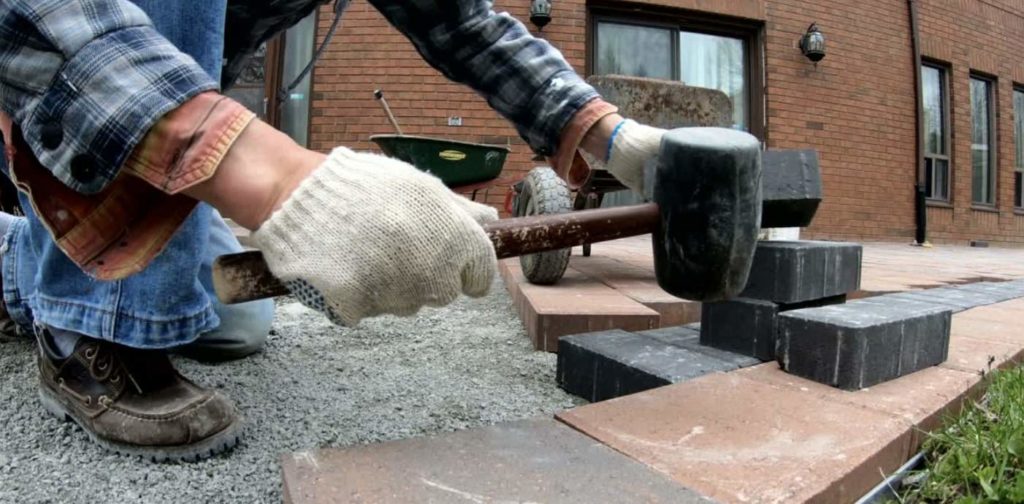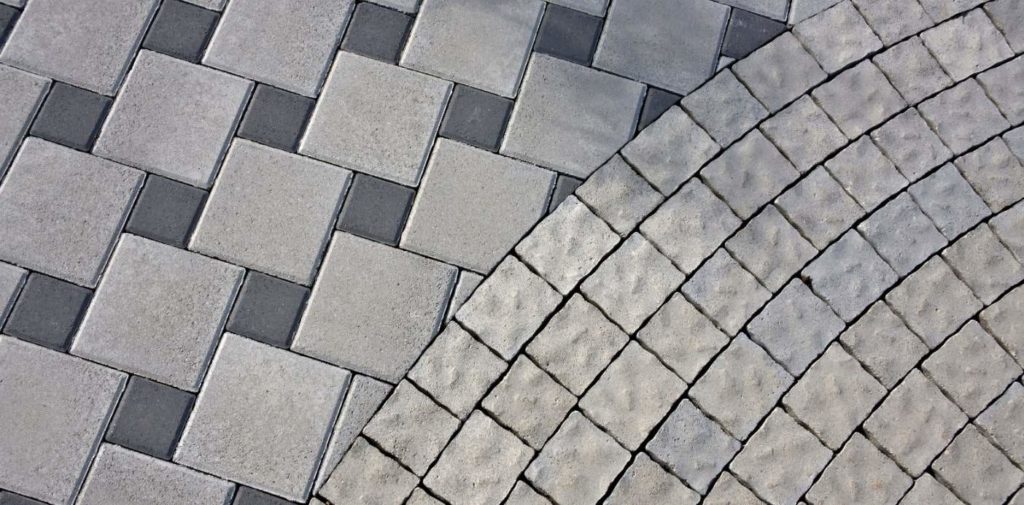Installing pavers over a concrete surface can be a good idea for homeowners. The pavers can quickly improve or refresh your worn or cracked concrete path, driveway, patio, or pool deck.
However, there are a few things you need to consider before topping up the concrete ground with new paving stones:
- The concrete surface has to be flat and smooth.
- The paving should fit snugly like a jigsaw puzzle to prevent tripping hazards.
- Using mortar is advised, as it protects the pavers from cracks or water leak issues.
Now, we’ll further analyze whether it’s practical to lay pavers over concrete here by going over their pros and cons, the best way to install them, and why you should enlist a pro’s help.
The Benefits of Laying Pavers over Concrete

Laying pavers on top of poured concrete ground has several benefits, which are:
1) It’s easy to install
Overlaying paving stones is a smart solution because it can be done directly on the concrete. The concrete won’t have to be removed at all, and so many people are going for it nowadays.
Although the appearance will be altered greatly from one sweeping slab to numerous consistent tiling, what’s important is that the surface is steady and durable to be used daily.
2) It hides the cracked or worn look of the concrete
Concrete isn’t everlasting and due to pressure, temperature, and weather, it can crack or leak after several years.
Paving stones are fantastic since if ever any of them breaks or cracks, it takes less effort to replace them than poured concrete.
And there’s a multitude of paving stone suppliers too. So, more often than not, suppliers can find exact or similar-looking pavers to change the damaged ones you have.
3) It comes in a myriad of styles, patterns, and colors
There are a ton of varieties for pavers on the market differing in styles, patterns, textures, and colors.
You can use brick, bluestone, concrete, marble, and basalt paving tiles, to name several. They have smooth, rough, or unique textures, and there’s at least one that will fit your desired look.
Concerning patterns, some lovely paving ones are herringbone with its 45 and 90-degree-oriented stones, the I pattern, and the running bond that’s reminiscent of the Old World European cobblestone walkways.
Experts say that it’s best to match the color of the tiling to your roof to create a unified house appearance. Paving colors can be anything from slate gray to crimson red, so you can surely find one that will complement your house’s aesthetics.
The Disadvantages of Laying Pavers over Concrete

This time, let’s look at the disadvantages of laying pavers over concrete:
1) It can be a costlier project to do
Since there’s no need to tear up the existing concrete surface, the work will be easier and often less costly to complete. However, there can be times that you will pay more expensively.
According to Install It Direct, you can expect to pay 10 to 15 percent more if you choose to install pavers over a concrete slab.
However, they wrote that the rate can be the same or less than if you opt to lay pavers rather than stamped concrete.
By the way, stamped concrete is a type of imprinted concrete that mimics natural stones such as brick, cobblestone, and slate.
2) The concrete has to be in good condition
Before paving stones are installed, the concrete ground has to be in a good state.
For instance, it has to be smooth, flat, and even as well as have its structural issues like cracks or erosion already addressed.
Otherwise, the paving stones can be damaged or won’t level with the ground well enough to achieve the picture-perfect result that you expect.
Correcting the issues to have the tiling done the right way will cost you additional expenses.
3) Improperly installed pavers can cause trip hazards
The pavers have to be fit and installed correctly and placed in a safe spot at your house.
They shouldn’t act as a blockage for gates and doorways nor cause accidental trips for those who pass by. The paving layout should be carefully and precisely planned beforehand.
And for this reason, we strongly recommended that you hire a licensed and highly skilled paving contractor than perform the work on your own.
The Price of Paving vs Concrete Removal and Installation

To help you decide between new concrete or pavers, let’s compare the average costs of paving against concrete removal and installation.
Usually, paver professionals charge their clients around $10 to $25 or $16.50 per square foot of tile installation.
Compare that to $4.34 to $16 per square foot for basic concrete addition plus $2 to $6 per square foot for concrete removal.
So, there’s a chance you will pay higher for having new pavers installed than having the existing concrete removed and a new one installed in place of it.
And also, the work will be more of a hassle with contractors and their equipment and industrial vehicles at your house.
How to Best Install Pavers over Concrete
The best way to install concrete pavers is to first pressure-wash the concrete slab or surface to clear it of dirt and debris. After it has dried, border pavers will be glued down with mortar to create a boundary.
Next, the contractor will pour one-inch thick sand all over the area within this boundary. This allows water to naturally flow out from the paving stones and the concrete surface.
Afterward, the pavers will be laid on top of the sand. And then, the joint between the pavers is filled with polymeric sand to hold the interlocking paving pieces together stably.
Why should I rely on a pro to lay pavers?

Although homeowners can carry out the paver installation themselves, hiring a pro is most often worth it.
With them, you wouldn’t have to gather the materials, plan the paving layout, and worry about the logistics. In short, they will handle all the project management for you.
You can just rely on the professionals to do the work very easily and in under a short time. You won’t even break a sweat thinking about the best paving material to use!
Moreover, you can rest assured that the workmanship will be top-notch, safe, and matches your desired look. Hopefully, you’ll be proud of it for many, many years.
And therefore, you’ll have peace of mind and be free of worries, knowing that all of the tile pieces are laid correctly and won’t cause any tripping hazard to the household, especially the kids and elderly.




